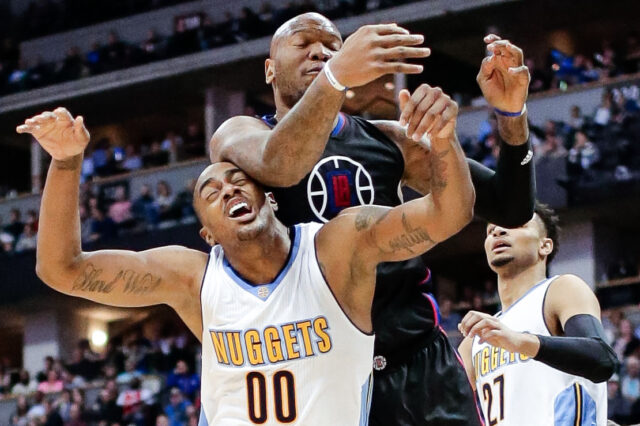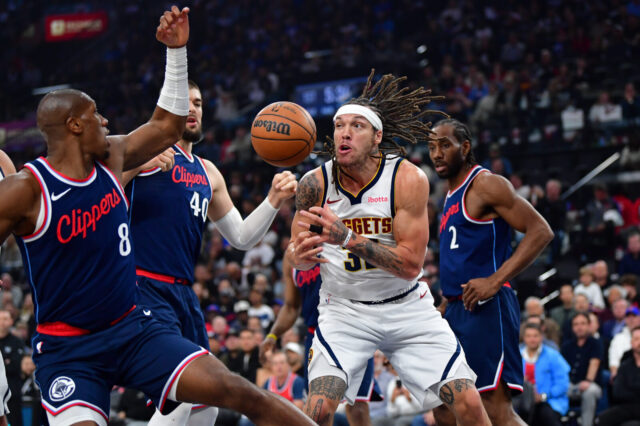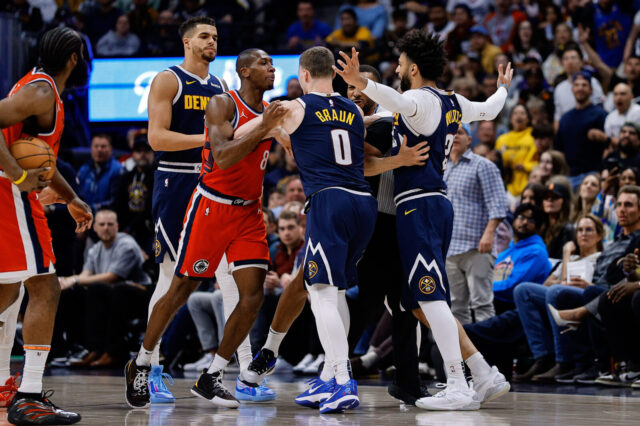The NBA Finals are in full swing after the conclusion of Game 2 last night. The majority of the NBA has moved on to draft season as fans prepare to see who their team will be adding to the roster. The Denver Nuggets are currently slated to pick 26th overall on draft night, and there should be some interesting prospects available for them to select. Continuing with the Stiffs draft profiles today is Gonzaga’s Corey Kispert. Kispert is one of the older prospects in this class, which is a drawback compared to yesterday’s subject, Usman Garuba, but he’s also one of the more polished players you’re going to find. Kispert is the type of player that fits well with this current iteration of the Nuggets’ roster. While some players are still developing, most have a specific role and are ready to compete for a championship. Kispert is a smooth and established offensive player that can come in and provide offense and shooting off of the bench.
Kispert was voted as a consensus All-American during his final season at Gonzaga, and he was also named the West Coast Conference Player of the Year. Kispert was the traditional modern Gonzaga player. He was a four-star recruit from Washington, and he received just five offers out of a high school. Of those five offers, only one came from a school East of Utah, Notre Dame. He took a few years to develop, and he was one of the best players in the country when he left. Some of those players, such as Buddy Hield out of Oklahoma, became NBA starters. Others, such as recent Gonzaga graduate Nigel Williams-Goss, played a whopping 50 minutes as a rookie.
Will Kispert be the next Hield that shows that draft age doesn’t matter? It’s possible.
Corey Kispert – Gonzaga
Vitals
Age: 22 (born March , 1999)
Height: 6-foot-7
Weight: 224 pounds
Wingspan: 6-foot-7
Per game Stats (Age-22 season)
| Season | Games | Minutes | Points | Rebounds | Assists | FG% | 3P% | TS% |
|---|---|---|---|---|---|---|---|---|
| Regular Season | 56 | 30.9 | 19.5 | 4.9 | 1.7 | 54.5% | 42.3% | 69.8% |
| Tourney | 8 | 34.8 | 15.9 | 5.3 | 2.0 | 46.8% | 38.4% | 61.4% |
Kispert’s final season was definitely his best. He was one of the two driving forces for a team that finished the year as the number one overall team in rating. His 44 percent mark from 3-point range was the best on the team of anyone that attempted more than two shots from outside, and he opened up the floor for fellow prospect Drew Timme, who did the majority of his work inside the paint. Kispert took over 50 percent of his shots from 3-point range, and, in the modern NBA where teams are always looking for more shooting, that’s going to be a key skill for him to maintain at the next level. He also shot 82.4 percent from the free-throw line in his four years at school, and he averaged 85 percent across his final three seasons. Being a player that can come off of the bench in crunch time to make free throws can go a long way towards being a rotational player compared to a guy that only plays minutes with less value.
Strengths
Shooting
Kispert shot a combined 43.9 percent over his final two seasons from 3-point range. Among the top small forwards in this draft, only Jalen Johnson of Duke shot a higher 3-point percentage in their career, but Johnson made just eight 3-point shots in his lone freshman season. Kispert had one game alon where he made 9-of-13 attempts on the night. He thoroughly gets the nod in that area.
In a quick comparison to the Nuggets’ players from this season, they had 3-point shooters at guard, but Michael Porter Jr. was the lone frontcourt player that was a consistent threat from outside. Will Barton was the team’s top wing player in 3-point percentage at 38.1 percent, and the team could use a player like Kispert to help space the floor both with the starters as well as with the reserves.
Kispert’s ability to knock down shots from outside forces opposing defenses to stay out on him and opens up driving lanes for other players. He also shot 62.8 percent from inside the arc this past season, so, when defenders close out on his 3-point shot, he can get past them to get up shots in the mid-range or to the rim if there is no help there waiting for him.
Ball Security
Kispert is unlikely to ever be a primary ball-handler when he’s on the floor, but he does have the ability to handle the ball without turning it over. Across 32 games in his final season, he had just 42 total turnovers despite a usage rate of 22.7 percent. Despite his high usage rate, he turnover percentage was only 8.7 percent. The only other player on the Bulldogs last season with a usage rate of 20 percent or higher along with a turnover percentage below 10 was Dominick Harris, who averaged just 7.2 minutes per game.
Kispert is the type of player that will be responsible for getting to spots and hitting jumpers off of passes from others, but it’s important to know that he doesn’t lose the ball if he drives to the rim. Something Michael Porter Jr. has struggled with at times is maintaining possession of the ball all the way to the hoop. While Kispert is going to play a different role from MPJ, it’s good to know he won’t feature that same wart to grow out of.
NBA Readiness
When you watch Kispert’s game, you can see the limitations and what his ceiling is as a player. However, you can also see how high the floor is. Kispert is going to come in and be a solid offensive player, and barring injuries, he’ll likely be a solid contributor for the next 5-to-10 years on that end of the floor. Most importantly, he can come in and contribute right away for a team that is looking to compete for championships.
Some players, such as Garuba, who we looked at a few days ago, need time to grow and develop. Kispert is who he’s going to be, and the only major adjustments he will have to make will be to the pace of play and the longer 3-point line. A team shouldn’t expect him to come in and be a major focal point or starter in Year 1, but he can be a rotational wing right away for a team that needs a little more juice on offense.
Weaknesses
Age
Operating off of this big board, there are just 11 players in the draft that are older than Kispert. Kispert is the highest ranked of that group, as he’s ranked 10th overall, but he’s also over two full years older than any of the nine prospects on the list ahead of him. At the top part of the draft, team’s tend to prioritize potential over polish in an effort to give themselves a greater chance at drafting a high-level player. That’s a major reason why older players, such as Kispert, tend to hear their names called later on draft night than younger guys.
In the last five NBA drafts, Buddy Hield is the only senior that was drafted in the top 10 in any of those five drafts. While the talent and polish of Kispert may make him a top 10 talent on draft night, he’s more than likely going to slide because of his age. Another small forward in this draft, Jonathan Kuminga, who still has a lot of work to do to round out his game, won’t turn 19 until October of this year, and that gives whichever team drafts him an additional three years to work on his game compared to a guy like Kispert.
NBA teams also tend to project a few years down the line which is another reason Kispert’s age is going to work against him. By the end of his first contract, assuming he plays all five seasons, he’ll be 27, which will have him in the middle of his physical prime, and, if he gets a four or five-year extension, he’ll be into his 30s which means you might only get two good contracts out of a player. Meanwhile, with someone such as Kuminga, a team could get an extra three years of play out of him.
Wingspan
At 6’7”, Kispert has decent height. He’s not supremely tall, but he’s not short either. However, while he has decent height, his wingspan is “technically” average for his height. It’s exactly 6’7” like his height is, and you generally are looking for more length in your wing players to get in the way of passing lanes and hold up better on the ball on the defensive end of the floor. For reference, projected top pick Cade Cunningham is also 6’7”, but his wingspan is 7’.
Kispert’s arm length isn’t going to be a huge deterrent to his success at the next level, but it does put a cap on his ceiling as a defender. Looking around the NBA, the best defenders tend to have longer wingspans than their actual height. Looking at the top three finishers in Defensive Player of the Year voting, all three have at least a slight length increase on their wingspan compared to their height. Kispert shouldn’t be docked too hard for this, but it is worth noting.
Passing
Kispert’s not going to be a point guard on the wing. That’s never been his game, but he will have to work on his passing at the next level. He has to always be willing to pass up a good shot for a guy that has a great shot rather than always taking his look when he gets it. He averaged just 1.8 assists per game during his final season at Gonzaga, and, per-36 minutes, that number only bumped up to 2.0 assists per. Even if he doesn’t become a primary ball-handler and distributor, he needs to give the defense the threat that he could pass up his shot.
Verdict
Kispert isn’t the player with the highest ceiling or most athleticism in this class, but he is one of the most polished and pro-ready players that you’re going to find. The Nuggets are a team that is ready to compete now with their window open thanks to the arrivals of Jamal Murray, Michael Porter Jr. and Nikola Jokic. Throw in the fact that Aaron Gordon and the rest of the starters were starting to gel prior to Murray’s injury, and you have a roster that needs rookies that can play from Day 1.
Kispert is that type of guy. His shooting and work on the offensive end of the floor, both on and off the ball, are skills that every team covet. The Nuggets are no exception to that rule. During the playoffs, it was quickly apparent that they had very little shot creation on the roster, and, even having a fully healthy roster wouldn’t have fully solved that problem. Kispert can go a long way towards remedying those weaknesses. He can knock down catch-and-shoot jumpers, and he can also get his own shot with the ball in his hands.
The key to Denver getting Kispert will be how far he falls on draft night. He’s currently projected to be drafted in the late lottery which would leave them looking elsewhere. His defense and age will likely push him down the board for teams looking for players that can compete hard on both ends of the floor, but will it push him down into Denver’s range? If it does, they should be thrilled to add the established scorer to their depth chart at 26.


